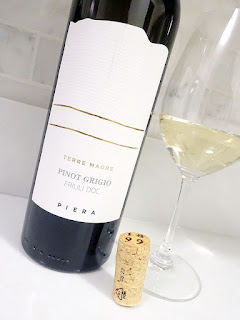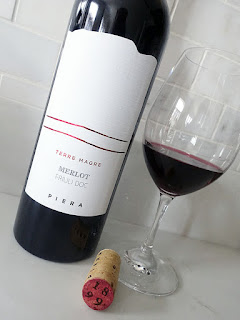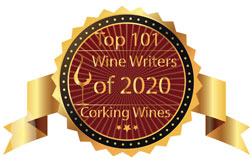Since rosé season is upon us, and it's the long weekend, rosé wine review is a lovely, certified sustainable rosé crafted locally in Niagara with 100% Pinot Noir. It arrived at the LCBO in last weekend's LCBO VINTAGES New Release Collection.
It is produced by Malivoire Wine Company, a pioneering wine producer that was established in 1996 by Martin Malivoire and his wife, Moira Saganski. Driven by a passion for viticulture and crafting distinctive wines, Martin transitioned from a successful career as Director of motion picture special effects and purchased a vineyard in 1995 in the Beamsville Bench area of the Niagara wine region and named it the Moira Vineyard. A couple of years later, the Malivoire acquired land at 4260 King Street East (Beamsville), which would go on to become their Estate Vineyard and the site of the winery. This site is located on a glacial moraine, 30 metres above the lakeshore plain and provides superior airflow and water drainage, which contribute to the quality of the grapes grown at the estate.
What started as a personal project, Malivoire Wine Company is now a showcase for innovation, creativity, and sustainability for the Ontario wine industry. The team at Malivoire is led by Martin Malivoire (Proprietor), Shiraz Mottiar (Team Principal and General Manager), and Elisa Mazzi (Winemaker). Shiraz joined Malivoire in 2000 after graduating from the first class at Brock University's Cool Climate Oenology and Viticulture Institute (CCOVI) and was promoted to Winemaker in 2005. Garnering numerous accolades and respect over the years, Shiraz continues to guide the winery and industry towards a more sustainable future. Elisa was hired and mentored by Shiraz, and in 2023 Elisa took over as Winemaker. The team at Malivoire isn't just a collection of employees - they're passionate professionals who have found their work-home with us. Malivoire firmly believes in providing opportunities for the team to evolve while staying true to its core values and objectives.
Since its founding, Malivoire has long been at the forefront of the Ontario wine industry, blazing a trail as a pioneer and leader in sustainable viticulture, defined by a steadfast commitment to innovation and stewardship of the land. Malivoire was one of the first to implement gravity flow methods and among the first to achieve certification under Ontario's Sustainable Winemaking Program. At Malivoire, sustainability is based on their "Three P" principles - Planet, People, Prosperity - and all three must be equally in balance to ensure success. Sustainability initiatives include Environmental Stewardship, Community Engagement, Education and Empowerment, Transparency and Accountability, and the Workplace.
Winemaking at Malivoire is a blend of innovative thinking with respect for tradition. They have a long-term view of the vineyard farms that recognizes the winery and vineyard as a wholistic system, and take responsibility for the health of the entire ecosystem, including the health and well-being of their staff working in the vineyard, winery, and their neighbours and community at large. Some of Malivoire's practices include Reduction & Elimination of Synthetic Inputs, Water Conservation, Hand Harvesting and Sorting, Energy Conservation, and Eco-Conscious Packaging.
The 2024 vintage of this wine comes to us in a somewhat refreshed, yet familiar package. The clear label appears dark salmon coloured in most lighting situations, and allows the white letters and beach chair to stand out. I like the new look! Like previous vintages, it is composed of 100% Pinot Noir. The grapes were grown on the estate within the Beamsville Bench appellation. The Pinot Noir clusters were hand-picked at cool, day-break temperatures on September 21st, and pressed immediately for optimum freshness. The resulting juice was chilled in a horizontal "dairy tank" prior to undergoing a cool fermentation in stainless steel, and finally bottled in January 2025.
The excellent growing season in 2024 had near-perfect growing conditions throughout, from early bud break to a warm and late fall that allowed for long hang time. It all began with a mild winter and no spring frost events. A warmer-than-usual spring was followed up by above-average temperatures in summer, with warm days and warmer-than-usual nights, which results in a reduced diurnal temperature range and produced grapes with intense flavours and colour development. Early fall had some moisture and disease pressure, leading to mild concerns about early-ripening, thin-skinned grapes such as Pinot Noir. During the harvest season, September had warm temperatures, while some humidity was linked to extreme weather events. From a very good-to-excellent vintage, let's see how this 2024 Pinot Noir Rosé from Niagara is tasting tonight...
Enclosed by Stelvin screw cap. 100% Pinot Noir with a pretty shade of pale salmon-copper. Medium+ to medium-high intensity aromatics of red berry, strawberry-rhubarb, cherry, melon, grapefruit, blood orange, zesty citrus, and raspberry aromas. It's medium+ bodied with very good weight and concentration on the dry palate with lovely red berry, strawberry-rhubarb, raspberry, melon, and citrus replays on the flavour profile. It's supported by clean, fresh, and lively acidity. Nicely textured and slightly tangy on the mid-palate. Touch spicy on the long, crisp, and savoury finish. Highly recommended buy! Score: 90+ pts
Other lovely wines by Malivoire Wine Company can be found at the LCBO, ordered direct from the winery in Niagara, or through their Agent - Noble Estates Wines & Spirits.
It is produced by Malivoire Wine Company, a pioneering wine producer that was established in 1996 by Martin Malivoire and his wife, Moira Saganski. Driven by a passion for viticulture and crafting distinctive wines, Martin transitioned from a successful career as Director of motion picture special effects and purchased a vineyard in 1995 in the Beamsville Bench area of the Niagara wine region and named it the Moira Vineyard. A couple of years later, the Malivoire acquired land at 4260 King Street East (Beamsville), which would go on to become their Estate Vineyard and the site of the winery. This site is located on a glacial moraine, 30 metres above the lakeshore plain and provides superior airflow and water drainage, which contribute to the quality of the grapes grown at the estate.
What started as a personal project, Malivoire Wine Company is now a showcase for innovation, creativity, and sustainability for the Ontario wine industry. The team at Malivoire is led by Martin Malivoire (Proprietor), Shiraz Mottiar (Team Principal and General Manager), and Elisa Mazzi (Winemaker). Shiraz joined Malivoire in 2000 after graduating from the first class at Brock University's Cool Climate Oenology and Viticulture Institute (CCOVI) and was promoted to Winemaker in 2005. Garnering numerous accolades and respect over the years, Shiraz continues to guide the winery and industry towards a more sustainable future. Elisa was hired and mentored by Shiraz, and in 2023 Elisa took over as Winemaker. The team at Malivoire isn't just a collection of employees - they're passionate professionals who have found their work-home with us. Malivoire firmly believes in providing opportunities for the team to evolve while staying true to its core values and objectives.
Since its founding, Malivoire has long been at the forefront of the Ontario wine industry, blazing a trail as a pioneer and leader in sustainable viticulture, defined by a steadfast commitment to innovation and stewardship of the land. Malivoire was one of the first to implement gravity flow methods and among the first to achieve certification under Ontario's Sustainable Winemaking Program. At Malivoire, sustainability is based on their "Three P" principles - Planet, People, Prosperity - and all three must be equally in balance to ensure success. Sustainability initiatives include Environmental Stewardship, Community Engagement, Education and Empowerment, Transparency and Accountability, and the Workplace.
Winemaking at Malivoire is a blend of innovative thinking with respect for tradition. They have a long-term view of the vineyard farms that recognizes the winery and vineyard as a wholistic system, and take responsibility for the health of the entire ecosystem, including the health and well-being of their staff working in the vineyard, winery, and their neighbours and community at large. Some of Malivoire's practices include Reduction & Elimination of Synthetic Inputs, Water Conservation, Hand Harvesting and Sorting, Energy Conservation, and Eco-Conscious Packaging.
The 2024 vintage of this wine comes to us in a somewhat refreshed, yet familiar package. The clear label appears dark salmon coloured in most lighting situations, and allows the white letters and beach chair to stand out. I like the new look! Like previous vintages, it is composed of 100% Pinot Noir. The grapes were grown on the estate within the Beamsville Bench appellation. The Pinot Noir clusters were hand-picked at cool, day-break temperatures on September 21st, and pressed immediately for optimum freshness. The resulting juice was chilled in a horizontal "dairy tank" prior to undergoing a cool fermentation in stainless steel, and finally bottled in January 2025.
The excellent growing season in 2024 had near-perfect growing conditions throughout, from early bud break to a warm and late fall that allowed for long hang time. It all began with a mild winter and no spring frost events. A warmer-than-usual spring was followed up by above-average temperatures in summer, with warm days and warmer-than-usual nights, which results in a reduced diurnal temperature range and produced grapes with intense flavours and colour development. Early fall had some moisture and disease pressure, leading to mild concerns about early-ripening, thin-skinned grapes such as Pinot Noir. During the harvest season, September had warm temperatures, while some humidity was linked to extreme weather events. From a very good-to-excellent vintage, let's see how this 2024 Pinot Noir Rosé from Niagara is tasting tonight...
Tasting Note:
MALIVOIRE VIVANT ROSÉ 2024 - Sustainable, VQA Beamsville Bench, Niagara Escarpment, Ontario, Canada (#498535) (XD) - $21.95Enclosed by Stelvin screw cap. 100% Pinot Noir with a pretty shade of pale salmon-copper. Medium+ to medium-high intensity aromatics of red berry, strawberry-rhubarb, cherry, melon, grapefruit, blood orange, zesty citrus, and raspberry aromas. It's medium+ bodied with very good weight and concentration on the dry palate with lovely red berry, strawberry-rhubarb, raspberry, melon, and citrus replays on the flavour profile. It's supported by clean, fresh, and lively acidity. Nicely textured and slightly tangy on the mid-palate. Touch spicy on the long, crisp, and savoury finish. Highly recommended buy! Score: 90+ pts
Other lovely wines by Malivoire Wine Company can be found at the LCBO, ordered direct from the winery in Niagara, or through their Agent - Noble Estates Wines & Spirits.






























